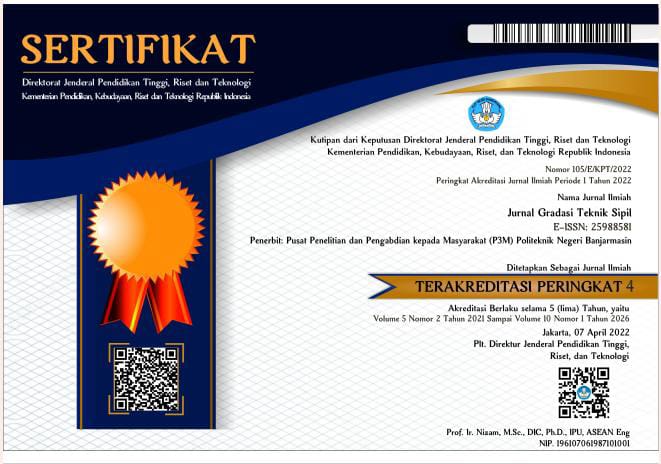Pengaruh Posisi, Jumlah Layer Dan Mutu Kayu Terhadap Balok Laminasi Kayu Mahang Dan Kayu Meranti
DOI:
https://doi.org/10.31961/gradasi.v2i1.560Keywords:
laminated beam, number of layers, quality of woodAbstract
Reduced forest products cause also reduced of large-dimensional wood that has high quality. One alternative to solve the problem is by doing laminate engineering by combining different quality wooden layers into specific sized beams as desired. The type of wood and the position of layer give effect to the laminate beam capacity. The aim of this research was to find out the flexural capacity (MOR) of Mahang and Meranti wood laminated beams which layers were varied which then the result of the laminated beam was compared with the solid beams. There were 3 types of laminate specimens made with dimension 5x7x76 cm3 which consisted of 7 layers; BL K1 beam consisted of 2 layers of Meranti wood at the top and bottom of the beam and 5 layers of Mahang in the middle; BL K2 beam consisted of 4 layers of Meranti wood at the top and bottom of the beam, and 3 layers of Mahang in the middle; and BL K3 beam consisted of 6 layers of Meranti wood at the top and bottom of the beam and 1 layer of Mahang in the middle. The test results showed that the use of wood of higher specific gravity at the outermost layer has increased the flexural capacity (MOR) and modulus of elasticity (MOE), particularly in laminated beams (Meranti wood and Mahang wood) with the same numbers of layers. Moreover, in same number or greater layer proportion between Mahang and Meranti wood, the result showed the increased of MOR and MOE of laminated beams compared with solid beam that has low specific gravity (Mahang).
Downloads
References
Anshari Buan. 2006. Pengaruh variasi tekanan kempa terhadap kuat lentur kayu laminasi dari kayu Meranti dan Keriung. Civil Engineering Dimension. Vol.8 No.1.
Awaludin ali. 2011. Penelitian sifat-sifat fisika dan mekanika kayu Glugu dan Sengon kawasan Merapi dalam rangka mempercepat pemulihan ekonomi masyarakat Merapi pasca letusan Merapi 2010. Diakses tanggal 10 Maret 2016, awaludin.staff.ugm.ac.id/files/2011/03
Awaludin, Ali dan Inggar Septhia I.(2005). Kontruksi Kayu. Jurusan Teknik Sipil. Universitas Gadjah Mada. Yogyakarta: Biro Penerbit.
Badan Standarisasi Nasional.(1994)) Metode Pengujian Kuat Tarik Kayu Di Laboratorium (SNI 03-3399-1994).BSN. Jakarta. Indonesia.
Badan Standarisasi Nasional.(1994) Metode Pengujian Kuat Geser Kayu Di Laboratorium. (SNI 03-3400-1994).BSN. Jakarta. Indonesia.
Badan Standarisasi Nasional.(1995) Metode Pengujian Kuat Tekan Kayu Di Laboratorium. (SNI 03-3958-1995).BSN. Jakarta. Indonesia.
Handayani S. 2016. Analisis Pengujian struktur balok laminasi kayu Sengon dan kayu Kelapa. Jurnal Teknik Sipil & Perencanaan. No.1 Vol. 18
Haygreen J.G dan J.L Bowyer. 1996. Hasil hutan dan ilmu kayu (Terjemahan Sujipto, A.H). Gadjah Mada University Press. Yogyakarta.
Iensufrie, Tikno. (2009). Mengenal Teknik Pengeringan Kayu. Surabaya: Erlangga.
Puluhulawa I, dkk. 2018. Pengaruh Penambahan Baut Dan Paku Terhadap Kuat Lentur Balok Laminasi Kayu Mahang Dan Meranti. INERSIA. No.1. Vol.XIV
Risnasari I, Azhar I dan Sitompul A.N. 2012. Karakteristik balok laminasi dari batang kelapa (Cocos Nucifera L) dan kayu Kemiri (Aleurities Moluccana Wild). Foresta Indonesia Journal of Forestry. No.1. Vol.2
Sari Rima J. P. 2011. Karakteristik Balok laminasi dari kayu sengon, Manii, dan akasia. Institut Pertanian Bogor.
Downloads
Published
Issue
Section
License
- Hak publikasi atas semua materi naskah jurnal yang diterbitkan/dipublikasikan dalam Jurnal Teknik Sipil ini dipegang oleh Dewan Redaksi dengan sepengetahuan penulis (hak cipta tetap dimiliki penulis).
- Ketentuan legal formal untuk akses artikel digital jurnal elektronik ini tunduk pada ketentuan lisensi Creative Commons Attribution-ShareAlike (CC BY-SA), yang berarti Jurnal Teknik Sipil berhak menyimpan, mengalih media/format-kan, mengelola dalam bentuk pangkalan data (database), merawat, dan mempublikasikan artikel tanpa meminta ijin dari Penulis selama tetap mencantumkan nama Penulis sebagai pemilik Hak Cipta.
- Naskah yang diterbitkan/dipublikasikan secara cetak dan elektronik bersifat open access untuk tujuan pendidikan, penelitian, dan perpustakaan. Selain tujuan tersebut, dewan redaksi tidak bertanggung jawab atas pelanggaran terhadap hukum hak cipta.








